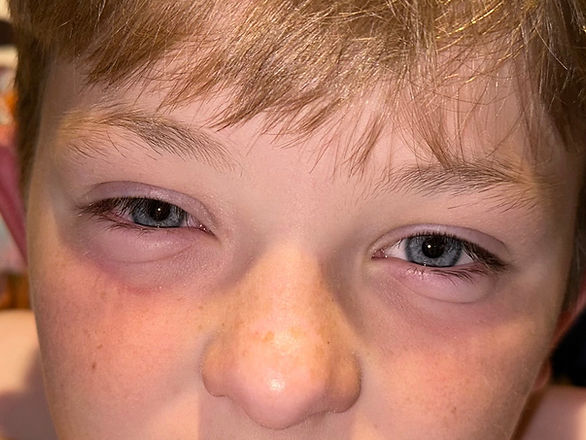
If you have a child that has allergies, especially serious food allergies you need to know how to create a child allergy action plan. My little guy, Brayden, who is 11 years old, deals with food allergies to milk, egg, peanuts, and tree nuts. If you’re walking this path with your child, you understand it’s like being on a constant mission to protect and care for them.
Understanding Allergies: What They Mean for Our Kids
Dealing with allergies is a bit like navigating a maze. For kids like Brayden, eating something they’re allergic to isn’t a small issue; it can be life-threatening. So, as moms, we’re always on alert, keeping an eye out for anything that could pose a risk to our children.
The Kitchen: Our Allergy-Safe Zone
Our kitchen at home? It’s like our fortress. It’s where we make sure everything is safe for Brayden. I’ve learned to read labels like a pro, always checking for milk, eggs, peanuts, and tree nuts. And cross-contamination? It’s a no-go. We have separate utensils and cooking equipment just for Brayden. It might sound like a lot, but it becomes second nature. Think of it as organizing your kitchen into different zones – one for allergy-safe cooking and another for everything else.
School Time: Partnering with Teachers When Creating a Child Allergy Action Plan
Schools can be a big challenge. But guess what? Teachers and school staff can be our best allies. I set up a meeting with Brayden’s teacher and the school nurse at the beginning of the year. We talked about his allergies, what to do in an emergency, and how to keep the classroom safe. It’s all about teamwork. And don’t forget about those class parties – I always send Brayden with his own allergy-safe treat so he doesn’t feel left out (it’s usually Pop-Tarts).
Social Life: Navigating Parties and Playdates
Birthday parties and playdates? They’re supposed to be fun, right? But when your child has allergies, they can feel like a minefield. My tip? Talk to the host beforehand. Explain your child’s allergies and maybe even offer to bring something Brayden can eat. It’s all about planning ahead. And always pack that emergency allergy kit – you never know when you might need it.
The Allergy Kit: Our Safety Net
Speaking of the allergy kit, it’s like our safety blanket. Brayden’s got his epinephrine auto-injector, some safe snacks, Benedryl, and his allergy action plan in there. It’s basically a guide on what to do if he has an allergic reaction. Make sure your kid knows about their kit, and if they’re old enough, how to use it.
Empowering Our Kids: Teaching Self-Advocacy
One of the biggest things I’ve learned? Teaching Brayden to speak up about his allergies. It’s about giving him the confidence to say “No, thanks” when he’s offered something he can’t eat and to tell an adult if he’s feeling sick. It’s not just about keeping him safe now, but also about preparing him for when he’s older.
The Emotional Side: It’s Okay to Be Scared
Let’s be real: managing allergies can be scary. Some days, I feel overwhelmed. But I’ve learned it’s okay to feel that way. Talking to other moms in the same situation helps a lot. Remember, we’re not alone in this. There are tons of us out there, all trying to do our best for our kids.
Education and Awareness
Beyond the kitchen and school, educating those around us plays a big part in our allergy action plan. It’s not just about telling people; it’s about helping them understand. When Brayden’s friends come over, I use it as an opportunity to educate them about allergies in a fun way. We make allergy-safe snacks together and talk about why certain foods are off-limits for Brayden. It’s amazing how understanding and supportive kids can be when they’re in the know.
Traveling with Allergies: The Adventure Continues When You Create a Child Allergy Action Plan
Traveling can be a bit of a hurdle with a child who has allergies. But don’t let it stop you! It’s all about planning. When we go on trips, I pack a good supply of safe snacks and research restaurants in advance. I even carry cards with Brayden’s allergy information in different languages when we travel abroad. And always, always, the allergy kit comes with us.
Doctor Visits and Allergy Tests: Keeping Up-to-Date
Regular check-ups with an allergist are key. Allergies can change over time, and keeping track is essential. Brayden gets tested regularly to see if there have been any changes in his allergies. This helps us adjust his diet and action plan as needed. It’s reassuring to know we’re always up-to-date with his health needs.
Cooking and Baking: Turning Restrictions into Fun
Cooking and baking allergy-safe recipes has become a fun activity for us. It’s amazing what delicious things you can whip up without milk, eggs, peanuts, or tree nuts. Brayden loves to help in the kitchen, and it’s a great way for him to learn about what he can eat. Plus, we’ve discovered so many new favorite recipes this way!
Emotional Support: Finding Your Community
Finding a community of parents dealing with the same issues can be a lifesaver. There are many online forums and local support groups where you can share experiences, tips, and get emotional support. It’s comforting to talk to people who really get what you’re going through.
Technology at Our Fingertips: Apps and Resources
There are some great apps out there for managing food allergies. They can help you find allergy-friendly recipes, translate allergy information when traveling, and even locate nearby hospitals in case of an emergency. Utilizing these tools can make managing allergies a bit easier and give you peace of mind.
Celebrations and Holidays: Allergy-Friendly Fun
Holidays and special occasions can be a bit challenging, but with a little creativity, they can be just as enjoyable. For Halloween, we do a sibling candy swap when trick-or-treating, so Brayden always gets candies that are safe for him like Sour Patch Kids or Twizzlers. For Christmas, we bake allergy-friendly cookies. It’s about creating new traditions that Brayden can fully participate in.

Handling Emergencies When Creating a Child Allergy Action Plan
The Role of EpiPen or Auvi-Q
When it comes to serious allergies, being ready for an emergency is crucial. This is where tools like the EpiPen or Auvi-Q come into play. These are not just medical devices; they’re lifelines for our kids.
What Are EpiPen and Auvi-Q?
EpiPen and Auvi-Q are types of epinephrine auto-injectors. They’re designed to treat severe allergic reactions, also known as anaphylaxis. Think of them as emergency helpers in a tiny package. They work by quickly getting medicine into the body to stop an allergic reaction.
Teaching Brayden About His Lifesaver
One of my main goals was to make sure Brayden understood how to use his EpiPen or Auvi-Q. We practiced with a trainer device (which doesn’t have a needle or medicine). I showed him how to hold it, where to inject (usually the thigh), and how long to press. It’s about making him feel confident in handling his own health, even in scary situations.
Spreading Awareness: Educating Others
It’s not just Brayden who needs to know how to use the EpiPen or Auvi-Q. Family, friends, teachers – basically, anyone who might be with him needs a quick lesson. I’ve done demonstrations for his classmates, teachers, and even our relatives. It’s all about making sure everyone in Brayden’s circle is prepared.
When to Use It: Recognizing an Allergic Reaction
Recognizing when to use an EpiPen or Auvi-Q is a critical skill. Symptoms of a severe allergic reaction can include trouble breathing, hives, swelling, and feeling faint. I always emphasize to Brayden and others that if in doubt, use the auto-injector. It’s better to use it and not need it, than need it and not use it.
After the Injection: Next Steps
Once the EpiPen or Auvi-Q is used, the next step is always to call emergency services. The injection buys crucial time, but it’s not a complete treatment. Doctors need to check everything’s okay and sometimes give more treatment.
Regular Checks: Keeping the Auto-Injector Ready
A little tip I’ve picked up is to regularly check the expiration date on Brayden’s EpiPen or Auvi-Q. These devices need to be replaced every so often. I keep reminders in my calendar so we’re never caught with an expired injector.
Empowerment Through Preparedness
Having a child with serious allergies means we’re always a bit on edge, but being prepared with an EpiPen or Auvi-Q brings peace of mind. It’s about giving our kids the tools and knowledge they need to feel safe and secure, no matter where they are. Remember, you’re not just managing allergies; you’re equipping your child with life-saving skills. Keep up the great work – your vigilance and love are making all the difference in your child’s life.
Step-by-Step Guide to Creating a Child Allergy Action Plan
Here’s a step-by-step guide to creating an effective child allergy action plan, tailored to be straightforward and practical for everyday use:
Step 1: Identify the Allergies
- Get a Professional Diagnosis: Start with a visit to an allergist to confirm your child’s allergies.
- Understand the Allergens: Learn about the specific foods or substances your child must avoid.
Step 2: Educate Yourself and Your Child
- Learn About the Allergies: Gather information on how to manage and treat the specific allergies.
- Teach Your Child: Explain the allergies to your child in age-appropriate language.
Step 3: Create an Allergy Action Plan for Your Child
- Draft the Plan: Write down clear instructions on how to handle an allergic reaction, including symptoms to watch for and steps to take.
- Consult Your Doctor: Have your child’s doctor review and approve the plan.
Step 4: Communicate with Schools and Caregivers
- Inform Educators and Caregivers: Share the allergy action plan with anyone responsible for your child’s care.
- Set Up Meetings: Discuss with teachers, school nurses, and caregivers how to manage your child’s allergies.
Step 5: Prepare for Emergencies
- Emergency Kit: Assemble a kit containing an epinephrine auto-injector (like EpiPen or Auvi-Q), antihistamines, and a copy of the allergy action plan.
- Train on Epinephrine Use: Ensure that family members and caregivers know how to use the epinephrine auto-injector.
Step 6: Allergy-Proof Your Home
- Create Safe Spaces: Keep your home free from allergens. If food allergies are the concern, create an allergy-safe zone in your kitchen.
- Store Safe Foods: Stock up on allergy-friendly foods.
Step 7: Plan for Social and School Activities
- Communicate with Hosts: Before social events, talk to hosts about your child’s allergies.
- Send Safe Snacks: Provide allergy-safe snacks for school or parties.
Step 8: Teach Self-Advocacy
- Empower Your Child: Encourage your child to ask about ingredients and to politely refuse unsafe foods.
- Role-Playing: Practice scenarios with your child where they need to communicate their allergies.
Step 9: Regular Medical Check-Ups
- Follow-Up Appointments: Schedule regular visits with the allergist to monitor the allergies and update the action plan as needed.
Step 10: Join Support Groups
- Find Community Support: Connect with local or online support groups for advice, emotional support, and to share experiences with other parents managing child allergies.
Conclusion:
This guide lays out the essentials in managing a child’s allergies, from identifying the allergens to empowering your child and ensuring their safety in various settings. Remember, the key is consistent management, open communication, and education. With these steps, you’re well on your way to creating a secure and allergy-aware environment and plan for your child.
Final Thoughts on Creating a Child Allergy Action Plan
As we finish talking about how to make a plan for kids with allergies, let’s remember this isn’t just about avoiding allergies. It’s a chance to teach our kids and ourselves about being safe and knowing what to do. By making a good plan, telling people about it, and giving our kids the right tools and info, we help make the world a safer place for them. Every step you take shows how much you care. You’re not just keeping your child safe; you’re helping them learn how to handle their allergies with confidence.



